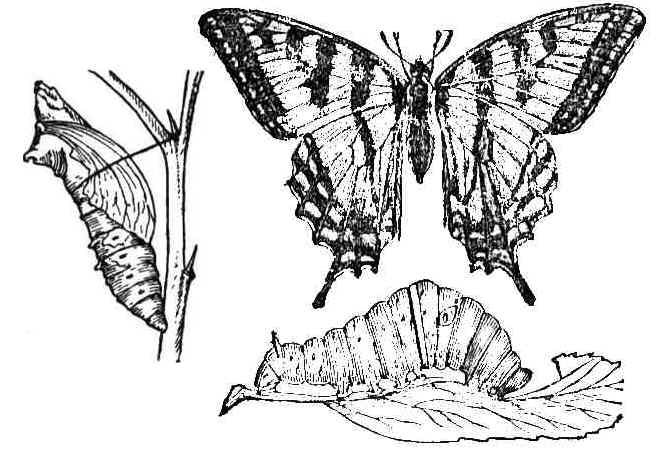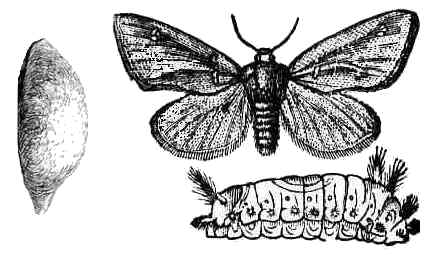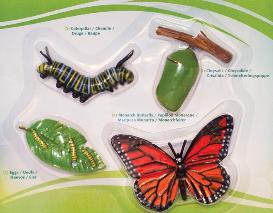|
|
Third Grade Integrated NGSS |
||
OBJECTIVE
·
Plastic models of moth and butterflies · Silkworm cocoons
·
Chrysalis of monarch
·
Scissors · Crayons · brads
VIDEO:
monarch egg to butterfly
https://www.youtube.com/watch?v=7AUeM8MbaIk
How to
tell a male from a female monarch BACKGROUND:
Moths and butterflies go through four life stages: egg, caterpillar, pupa,
and adult. The length of the life cycle varies from species to species.
Butterflies and moths both lay eggs which hatch into caterpillars of
different shapes and sizes depending on the species. The caterpillar feeds
usually on leaves and grows very rapidly. It molts (sheds) its skin and
develops a new one as the body grows. The metamorphosis begins when the
caterpillar uses silk to attach to a plant. The skin hardens to form a
chrysalis (for a butterfly) a cocoon for a moth. Within the chrysalis and
the cocoon the caterpillar changes to the butterfly and moth respectively.
In the adult stage the main purpose is to eat and to lay eggs. Butterflies
and moths usually only live for several weeks
Main differences (generally) between butterflies and moths
·
Butterflies fly by day and most moths by night
·
At
rest butterflies hold their wings closed together over their backs whilst
moths rest with their wings spread out sideways
·
Butterfly antennae are long, thin and clubbed at the end, most moth
antennae are shorter and feathery PROCEDURE:
1.
Read the Painted Lady and go over
the information at the end, especially the difference between a moth and a
butterfly. Stress that there
are many types of butterflies and moths and their specific color, egg,
chrysalis, caterpillar, and adult all look different.
2.
Let
the students look at the models of the Luna Moth and Monarch butterfly.
Have them put it in the correct order. Have a discussion that
brings the students to compare and contrast.
Life
Cycle of a Monarch Butterfly
Caterpillar (Larva):
The caterpillar hatches from the egg in 3-12 days.
As soon as it emerges, the caterpillar begins to eat milkweed
leaves that are toxic to many insects but not to the caterpillar.
Chrysalis (Pupa):
The caterpillar encases itself in a beautiful jade green shell with
gold markings. This
coloration camouflages the shell from birds while inside the caterpillar
begins the transformation into a butterfly.
Adult
(Butterfly):
When the butterfly is mature it emerges from the chrysalis.
The Monarch’s wings are folded up and they must be pumped up by the
butterfly in order to straighten them.
Once the wings are dry the butterfly can fly.
After 2 to 5 weeks the adult butterfly will reproduce and lay eggs.
Life
Cycle of a Luna Moth
Caterpillar (Larva):
The newborn caterpillar constantly feeds, eating several leaves daily.
As it grows the caterpillar will molt, crawling out of its old skin
having formed a fresh, new skin underneath.
It will grow to its full size of about 2 inches (5 cm) long.
Cocoon
(Pupa):
The caterpillar pulls a leaf around itself and spins a cocoon, a
protective covering, winding thread around its body.
After a week, the caterpillar becomes a pupa where it will
transform into a moth. Three
weeks later, the adult moth will push itself free.
Adult
(Moth):
At first, the Luna Moth’s wings are soft and wet.
I must immediately find a place to hang and dry its wings before it
can fly away. An adult moth
does not eat, living for about one week during which it will find a mate
and reproduce.
3. Have the students make a monarch “life cycle wheel.” Stress to use the models to make the Monarch realistic with color and patterns. 4.
Show the video of the monarch lifecycle.
OPTIONAL: Students like to be
able to tell if the butterfly or moth is a boy or a girl.
For Monarchs males have spots on their hind wings and females have
thicker black veins.
(If they ask, for the luna moth, the males have bushier antenna.)
|
|||


 Moths and butterflies belong to the group called the Lepidoptera. They are
medium to large sized insects with mouthparts reduced to form a coiled
tube for sucking liquid food
Moths and butterflies belong to the group called the Lepidoptera. They are
medium to large sized insects with mouthparts reduced to form a coiled
tube for sucking liquid food
